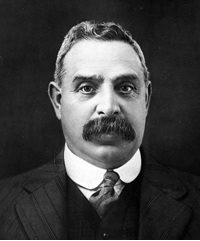
Date of Birth: 04/03/1864
Place of Birth: Dilhorne, Staffordshire, England
Date of Death: 14/12/1928
Place of Death: Strathfield, New South Wales, Australia
Parliamentary Service
| President of the Legislative Council |
27 Apr 1915 |
14 Dec 1928 |
13 years 7 months 18 days |
|
| Minister of Public Health |
22 Apr 1914 |
27 Apr 1915 |
1 year 6 days |
|
| Minister of Public Instruction |
27 Nov 1911 |
29 Feb 1912 |
3 months 3 days |
|
| Colonial Secretary and Registrar of Records |
07 Nov 1911 |
26 Nov 1911 |
20 days |
|
| Secretary for Lands |
04 Aug 1911 |
26 Nov 1911 |
3 months 23 days |
|
| Vice President of Executive Council and Representative of Government in the Legislative Council |
21 Oct 1910 |
27 Apr 1915 |
4 years 6 months 7 days |
|
| Member of the NSW Legislative Council |
12 Jun 1900 |
14 Dec 1928 |
28 years 6 months 3 days |
Life Appointment under the Constitution Act. Date of Writ of Summons 6 June 1900. |
Political Party Activity
Australian Labor Party (ALP). Chairman of Labor Electoral League 1894; first president of the Political Labor League 1895, holding position until 1898; Labor candidate for Legislative Assembly in 1890s and for Australasian Federal Convention 1897; delegate to federal conference 1900; member central executive to 1912; president 1906 until 1907.
Qualifications, occupations and interests
Painter and plasterer. Arrival at New South Wales with family c. 1882. Worked as painter and plasterer; joined United Painters' Trade Society, representing it on the Trades and Labor Council. Vice President of the Trades and Labor Council in 1892. Commissioner of the New South Wales Fire Board, Chairman 1915; Chairman and Trustee of Taronga Park 1912-1928; Chairman Tramway Construction Board 1920; Director of Royal Prince Alfred Hospital 1916-1918; Director of New South Wales Travel Bureau Ltd 1926; Member Meat Industry Board; active Member Abbatoirs Employees' Welfare Association; Member Universal Pervice League 1915; President South Sydney Rugby League Club 1908-1928; Patron PSW Rugby Football League 1910-1928; first Chairman League's Australia Board of Control 1924. Led Temperance Mission, Newtown, 1892. Author of The Hospital System in New South Wales, 1912-1913.
Membership of other Parliaments & Offices Held
Local Government Activity
Personal
Son of William, gardener, and Dorothy Robinson. Married Annie Foster on 26 January 1888 at Sydney and had issue, 2 sons and 2 daughters. Church of England.
Additional Information
Text from the book: 'The Presiding Officers of the Parliament of New South
Wales', Sydney, 1995
Frederick Flowers was born on 4 March 1864 in Staffordshire, England. He
arrived in New South Wales as young man and married Annie Foster on 26 January
1888. They had two sons and two daughters. A painter by trade, Flowers joined
the United Painters' Trade Society and worked his way up through the Industrial
Labour Movement. A pioneer of the political Labor movement, Flowers was closely
associated with the formation of the Labor Electoral League in 1890 and 1891.
He became the first President of the New South Wales Labor Party, which until
1918 was referred to as the Political Labor League. As Chairman of several
Annual Labor Party Conferences, Flowers emphasised the importance of the
party's educative functions as well as the importance of its pursuits outside
of Parliament. Flowers was deeply involved in the development and expansion of
Taronga Park Zoo over a number of years.
Flowers unsuccessfully contested the seats of South Sydney in 1891, Newtown-St
Peters in 1895 and Waterloo in 1898 and despite the Labor Party's intention to
abolish the Legislative Council because of difficulty in obtaining seats,
William Lyne appointed him to the Legislative Council in 1900. At that time
Labor held five seats in a House of sixty. In the State's first Labor
Government of 1910, Flowers became Vice President of the Executive Council and
the Government's Representative in the Legislative Council. As a Minister,
Flowers made many important contributions including improvements to police
working conditions while Colonial Secretary, and as the first Minister for
Public Health he oversaw the introduction of public health centres for mothers
and infants. Appointed President of the Legislative Council in 1915, he was
admired for the efforts he took to orientate new Members with Parliamentary
procedure and his willingness to consult with Officers of the House. Although
he split with the Labor Party over the conscription issue in 1916 he remained
the President of the Council until his death from diabetic complications on
December 14,1928 at Strathfield.
